Koh Lanta dive sites
The Koh Lanta dive sites are all dive sites as interesting as they are varied. Spread over 2 marine national parks, they are among the most beautiful dive sites in Thailand.
Some sites are in the world’s top 10 and attract divers from all over the world.
If you are wondering what to do in Koh Lanta, scuba diving is one of the activities not to be missed!
Therefore, doing a PADI diving training, a day “diving excursion” or simply discovering scuba diving in Koh Lanta is undoubtedly an extraordinary moment of discovery.
Do you want to know a little more about the best diving organization in the world? PADI !!
Ko Haa (1)
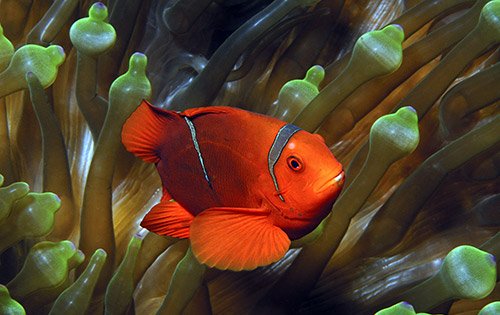
| Visibility | 10 to 30 meters |
| Depth | 5 to 30 meters |
| Current | Mild |
| Level | Beginner – Advanced |
This beautiful island, known for its swim-throughs and the famous “Chimney”, offers divers of all levels enjoyable dives.
There are usually 2 ways of diving the island, depending on the currents. One option is to jump in the water as the waters are rising at the “Chimney”, first swim in the fish-bowl after which you ascend straight down into the blackness of the “Chimney” and exit this vertical swim-through horizontally at about 18 meters of water. This requires advanced buoyancy control. From here you can choose to proceed with your dive plan either towards the deep wall of the northern side, or the shallower side of the island.
If you choose the deep walls, after entering you can exit the “Chimney” at 18 meters and then slowly descend further into a swim-through which takes you to a beautiful coral garden of purple and white leafy soft corals at about 22 meters. You can then proceed towards the northern wall of the island which descends to over 20 meters in depth straight down. The wall is covered by beautiful fan corals and other corals, both hard and soft. Different types of moray eel and the ever-elusive harlequin shrimp also live in these walls. Always remember to periodically look “in to the blue”, because that’s where the big things lurk.
Alternatively you can take a leisurely dive towards the shallow southern and western slopes, ending the dive at the finger reef where plentiful of large crocodile needle fish, Trevallies and smaller fish congregate ensuring a mesmerizing end to the dive. On these slopes there are plentiful of beautiful anemones with colorful “Nemo’s” living in the safety of the stinging tentacles of the anemone. On the way towards the finger reef, divers can enjoy plentiful schools of fusilier on the hallow southern and western slopes of the island. Also turtles are known to live around this island.
Ko Haa Lagoon (2, 3, 4)
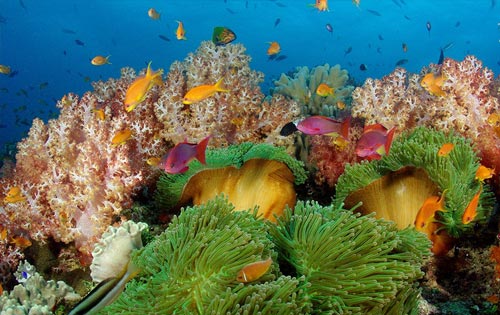
| Visibility | 10 – to 30 meters |
| Depth | 5 to +40 Meters |
| Current | Milf |
| Level | Beginner – Advanced |
Koh Haa Lagoon lies embedded in between 3 islands, #2, #3 and #4. This dive site is the perfect place for divers of all comfort and certification levels to dive. The Lagoon is the ideal place to learn and practice your buoyancy or navigation skills, then lead dives towards the 2nd and 4th islands and their beautiful slopes and walls. The lagoon itself is a plateau which begins from a small beach and extends to the edges in 3 directions, opening up to the open ocean and deeper depths.
Koh Haa 2 offers a variety of features. On the lagoon side the dive is shallow and you can often spot a large school of barracuda there. Depending if you choose to dive “right or left shoulder”, your dive will eventually lead to the outer slopes and walls of #2. Around this islands shallows you can find dragon sea moths, large brown marbled groupers, turtles and even those difficult-to-spot stonefish. The island is punctured through by a shallow swim-through, which is accessible on higher tides. Ask your instructor/divemaster more about diving through, as a safety-stop will be required before entering this swim-through at the end of the dive.
Koh Haa 4 is very similar to Koh Haa 2 in topography with a few exceptions. You might want to lead this dive by jumping in the lagoon and choosing to go “left shoulder”. As you are going around the rock formations towards the outside of the island, you will come across a shallow swim-through, which rises to about 3-4 meters, which is why attempting this swim-through, you should start your dive here or make sure you make your safety stop before going for this swim-through as a safety-stop will be required before entering at the end of the dive here as well.
After this you can choose to stay shallower, saving both air and bottom time before descending down to a beautiful outer reef at about 32 meters. Before descending further, look out into the blue to your right to catch that beautiful school of giant batfish often lingering along in the blue. The deep reef itself is riddled with corals, both hard and soft, schools of snapper hunted upon by trevallies and emperors, also large giant moray eels and the occasional larger ray are often tucked away under the rocks and corals.
For friends of shallower dives, the walls of #4 are riddled with macro life as well. Many species of nudibranch and also pipefish and tiger cowries live in the small nooks and crannies of the walls.
A few smaller reefs in between #2 and #4 host massive amounts of glass fish and different types of crab and shrimp. This in turn attracts other creatures such as ornate ghostpipefish and other predatory fish as well, such as the battle-ship-like lionfish. Before peering under the corals, make sure you know what lurks in the midst of all those glass fish before going further.
Ko Haa Lek (6)
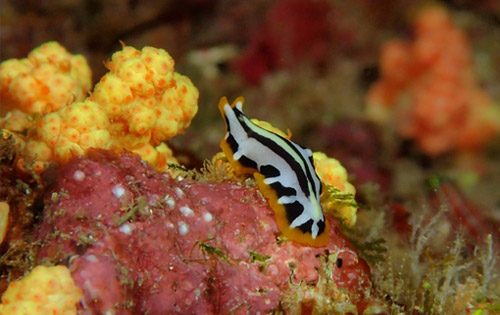
| Visibility | 10 to 30 meters |
| Depth | 30 meters |
| Current | Mild |
| Level | Beginner – Advanced |
Koh Haa Lek aka Koh Haa 6 is a tear-off from Koh Haa Yai. It is a small island with topography similar to Koh Haa 1. You can jump in on the western side and if currents favor you, you can have a nice, colorful ride along the wall to the eastern side. On a nice day it’s also nice to go around the island and then take heading towards Koh Haa Yai on the connecting ridge. This route is riddled with huge purple barrel sponges and other corals. This way you can end your dive on the western end of Koh Haa Yai and perhaps spot a few black-tip reef sharks cruising along in the shallows on your way to the safety-stop.
Ko Haa Yai (5)
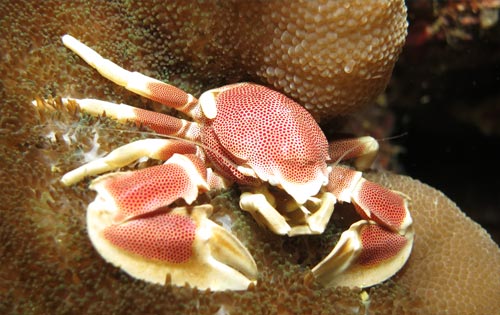
| Visibility | 15 to 30 meters |
| Depth | 5 to +40 meters |
| Current | Mild |
| Level | Beginner – Advanced |
Koh Haa Yai, also known as Koh Haa 5, is home to the so-called “Cathedral”. Two side-by-side caverns base at about 10-12 meters of water and are connected at about 8 meters by a window, which you can swim through. So, to begin the dive, you can descend and enter the cavern as soon as possible. Then ascend back to the surface and take a breath of fresh air in the air pocket above. After this you descend back down and continue the dive in the cavern. When you decide to exit, there are both two big entries to choose from, or you can also choose the eastern swim-through exit. You can choose between a few options, but all of them require first entering a small chamber before exiting from the swim-through most fitting to your buoyancy control ability and comfort level. Do not crowd the chamber or swim-throughs. After you exit the chamber your options are to follow the current “left-shoulder” to the eastern walls and slopes to spot giant moray eels, huge purple barrel sponges etc. before going around the islands edge and towards shallower depths on the shallow reef on the “beach” side of Koh Haa 5 where you end the dive.
Optionally you can choose exiting the swim-throughs towards the west, or “right-shoulder”, examining the topography and colorful walls before entering the realm of the famous yellow tigertail seahorse. This beauty sits at about 18 meters and for the last 1,5 years has been the most photographed celebrity around these parts. So please, keep your photos to a sensible limit and don’t shine your lights directly at this little beauty. Also, remind yourself and your buddy of buoyancy control around this fragile creature and it’s home surroundings. After this you can slowly ascend towards the shallower reef for your safety stop.
Ko Bida Nai (9)

| Visibility | 10 to 25 meters |
| Depth | 30 meters |
| Current | Mild |
| Level | Beginner – Advanced |
Koh Bida Nai, the smaller of the two Bida Islands, has its own entertaining characteristics. Although not as colorful and beautiful as previous years, this site still offers good snorkeling on the north side and several swim-throughs on the south side.
The western wall of Bida Nai is very similar to the 30 meter wall of Bida Nok in both topography and fauna. Beautiful sea fans decorate the walls along with other corals. Keep away from the walls, it is always possible to see the Leopard shark “also called Zebra shark” resting on the sandy bottom around “Fantasy Reef. »
Ko Bida Nok (8)
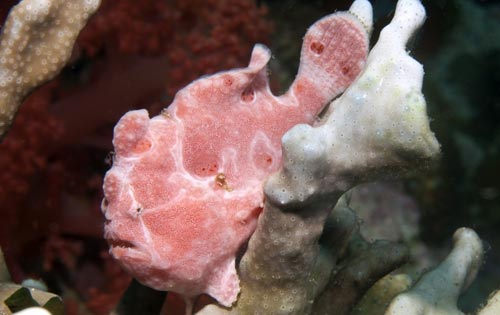
| Visibility | 10 à +25 meters |
| Depth | 30 meters |
| Current | Mild |
| Level | Beginner – Advanced |
Koh Bida Nok is the southern most of the Phi Phi islands for diving. This dive site offers several distinctive features such as the bay area, a 30 meter wall, the finger reef and ofcourse the outer pinnacles. Courses and beginners can start their dive easily from the bay from where you take heading according to currents to either towards the shallow slopes of the east side, or if currents are against you, you can dive out of the bay and around the finger reef, which has huge schools of fusilier hunted down upon by trevallies. On this side it’s not uncommon to catch a glimpse of turtles as well.
For those who want a more challenging dive, they can jump on the western wall. Descend down to 30 meters where you will meet with the bottom and from there slowly begin your ascent to which ever direction the current carries you. The 30 meter wall is beautifully decorated by colorful sea fan and other corals. As for marine life, the wall is teeming with life. All you have to do is bring your torch with you to find those elusive critters in the cracks of the wall.
If possible, it’s always good to end your dive in the bay or the shallows of the east to see black-tip reef sharks cruising around the reef on the surface layers.
Klaed Kaew Wreck (7)
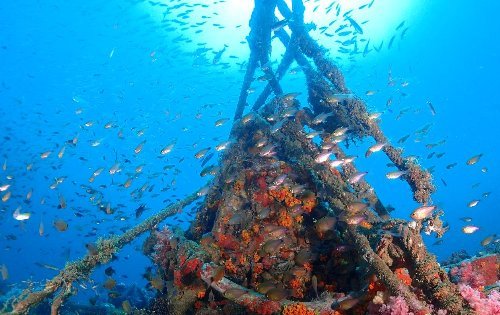
| Visibility | 10 à +30 meters |
| Depth | 27 meters |
| Current | Mild – Moderate |
| Level | Avanced |
Klaed Kaew was originally built in Norway, but some years later sold to the Royal Thai Navy in 1956 as a support ship until it was scuttled on the 19th March 2014 east of PhiPhi Ley. Since then this wreck / artificial reef has offered sanctuary to hundreds of thousands of marine creatures. Initially many frogfish were found around the wreck, but the lionfish invasion made sure all those remaining frogfish stay well hidden within the structures of the wreck.
The wreck dive itself begins at the surface buoy. Slowly using the line as reference we descend down towards the wreck and the bottom that Klaed Kaew rests on. Descending down to 26 meters and then slowly starting our ascent while going around the wrecks features. Visibility can sometimes be challenging, but even on those days these dives will be memorable due to the sheer volume of life here.
The wreck itself is covered in life. All over the wreck you will find massive lionfish, which don’t always bother getting out of the way. So as you go through the vortex of snapper and fusilier scholes, be weary that there might be a big Pacific lionfish down-current in the midst waiting for you. Small scorpion fish also habit this wrecks top decks. They will be resting or hunting on the ridges and sides of the boat. In addition to these fellows, you can’t miss the vast amount of porcupine fish, which love to feed on sea urchins, which also inhabit the wreck in large numbers. Remember your buoyancy control.
On good visibility days, always take a habit of looking into the blue. There might be schools of big barracuda or batfish. However, the most impressive inhabitant here would be the giant grouper that lives somewhere inside the wreck. On occasion it can appear from the blue and surprise you by floating by your shoulder into the wreck. This impressive creature is about 1,5 meters in length, last seen by Lazy Seal staff in 2016.
Once you have used up your air or bottom-time, we have already navigated back to the buoy line on which we ascend to our safety-stop before surfacing and getting ready for new adventures. This site is perfect for Nitrox due to it’s depth. Please ask you Instructor/Divemaster for more information on the Nitrox-Specialty course for longer bottom times.
The wreck is penetrable, but only with the proper equipment and training. Wreck-Specialty courses can be conducted here with our instructors. As a general rule Lazy Seal is strongly against entering wrecks or accessing caves without proper training, experience and equipment.
Hin Bida (10)

| Visibility | 10 à 25 meters |
| Depth | 5 à 20 meters |
| Current | Mild – Moderate |
| Level | Beginner – Advanced |
Hin Bida is a mostly submerged finger reed located between Koh Bida Nok and Koh Maa. This 3-finger reef is almost a sure site to see zebra sharks, often mistakenly called “leopard sharks”.
The rocky side where divers usually jump off during receding waters lead down towards the south with three separate “fingers”. As you cruise along these reefs, you will meet colorful trumpet fish, Snapper, honeycomb moray eels, crown of thorn sea stars, cuttlefish and many other creatures. But mainly on this dive it’s important for divers to look at the sandy patches embedded in the reef. These are the spots where zebra sharks like to take their rest. The animals themselves are very docile and can be approached up to a certain point, but be sure to leave plenty of space for your own and especially the animals comfort.
Hin Klai (11)
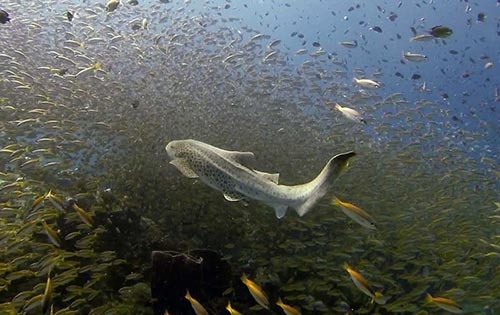
| Visibility | 10 à 25 meters |
| Depth | 17 meters |
| Current | Mild – Moderate |
| Level | Beginner – Advanced |
Hin Klai is very similar to Hin Bida in topography, without the finger reefs. Out in the open ocean and sometimes tricky to find, this site is not dived too much. Mostly there are no other dive boats around and due to divers not going here too much, the corals and the site itself is lush and plentiful with sea fans, anemones and barrel sponges.
To begin the dive, we drop down in open ocean on this shallow pinnacle which goes down to about 7 meters. From the top this lively little pinnacle the gentle slopes drop down to about 15+ meters. The site itself is covered in anemones, sea fan corals and the rock formations beneath them, which offer safe haven for the animals inhabiting this site.
This small site in size is actually a big dive. Scholes of fish entertain you while cuttlefish are out playing their mating games. When you go on the sandy bottom to the outside, you will most likely catch a glimpse of either zebra sharks or Kuhl’s stingrays. It is not uncommon to see pipefish on the sandy bottom as well.
Currents can sometimes be a bit stronger here, so divers should prepare to apply drift diving techniques.
Hin Daeng
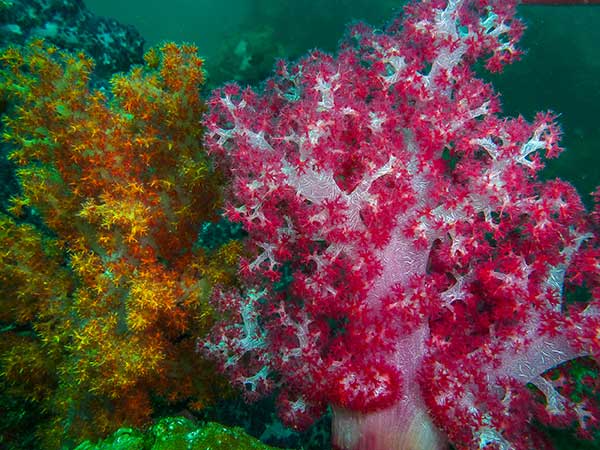
| Visibility | 10 à 30 meters |
| Depth | 5 à +40 meters |
| Current | Mild – strong |
| Level | Advanced |
Hin Daeng means “Red Rock” in Thai and is aptly covered by corals and sponges of such color. These site is the top of the game around these parts of the world. Hin Daeng offer all sorts of adventures for the more experienced divers. And in addition to Manta Rays there’s a good chance of seeing Whale Sharks here as well.
These site is situated close to Hin Muang at the west, the Himalayas of the Andaman. This site is like a chain of mountains joined together with little depressions leading to the other side. This mesmerizing dive site easily takes you to all possibilities. There are so many life on these sites that we’ve had a lot of things to do, just sit quietly pondering what they had seen, where they just were.
You can start your dive on both this site on a mooring line. The currents on these sites can be reduced to one of those massive rock formations. As the walls of this site fall down to 40+ meters and even deeper, they should be of particular importance. It is easy to lose yourself in these majestic settings.
Thousands of blue Red Tooth Triggerfish hovering around the walls looking for their next meal while large Trevally and Emperors are on the hunt. The walls are riddled with so much life, it is sometimes difficult to remember what you have seen during the dives. This site is perfect for the Deep Specialty-Courses and the 40 meter maximum depths are extremely easy to go down to these site. Also Enriched Air Specialty and Drift-Specialty would be highly useful races here.
Hin Muang

| Visibility | 10 à 30 meters |
| Depth | 5 à +40 meters |
| Current | Mild – strong |
| Level | Advanced |
Hin Daeng means “Red Rock” in Thai and is aptly covered by corals and sponges of such color. This site is the top of the game around these parts of the world. Hin Daeng offer all sorts of adventures for the more experienced divers. And in addition to Manta Rays there’s a good chance of seeing Whale Sharks here as well.
This site is situated close to Hin Muang in an east-west position. This site is like a chain of mountains joined together with little depressions leading to the other side. This mesmerizing dive site easily takes you to all possibilities. There are so many life on these sites that we’ve had a lot of things to do, just sit quietly pondering what they had seen, where they just were.
You can start your dives on this site on a mooring line. The currents here can be reduced to one of those massive rock formations. As the walls of this site fall down to 40+ meters and even deeper, they should be of particular importance. It is easy to lose yourself in these majestic settings.
Thousands of blue Red Tooth Triggerfish hovering around the walls looking for their next meal while large Trevally and Emperors are on the hunt. The walls are riddled with so much life, it is sometimes difficult to remember what you have seen during the dives. This site is perfect for the Deep Diver Specialty Courses and the 40 meter maximum depths are extremely easy to go down to these site. Also Enriched Air Specialty and Drift-Specialty would be highly useful races here.
Anemone Reef (13)
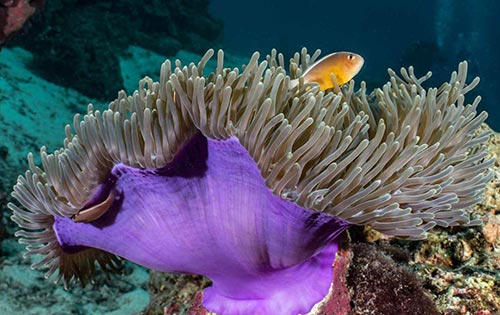
| Visibility | 10 à 25 meters |
| Depth | 5 à 30 meters |
| Current | Mild – moderate |
| Level | Beginner – Advanced |
Situated in the same cluster (SKA) as King Cruiser and Shark Point, Anemone reef can be one of the best dive sites on Phuket side of PhiPhi. The dive site itself is buried under water at about 5 meters. Depending on the currents, you start to maneuver your dive accordingly around this pinnacle and towards the end of the dive make your safety stop and ascend to the surface where the boat will pick you up.
On this site anemones and “Nemo’s” of course are abundant and you also get to experience big scholes of snapper, barracuda, trumpet fish and other critters of the deep. As Sharkpoint is so close to this site, it is no wonder to spot zebra shark here as well. It’s worth saying that the volume of Anemone on this site is mesmerizing. It guarantees a beautiful dive, just floating above the tentacles of hundreds and hundreds of anemones in their blue and green costumes. As is Sharkpoint, this site also sometimes gets hit by strong currents, so drift diving techniques should be applied.
Shark Point (12)

| Visibility | 10 à 30 meters |
| Profondeur | 5 à +40 meters |
| Current | Mild moderate |
| Level | Beginner – Advanced |
Shark Point is a 3-pinnacle adventure in to the world of sharks, situated between Phuket and PhiPhi. This site is an open ocean site, with one of the pinnacles standing out of the ocean. The site itself is covered in corals, both soft and hard. On this foundation its easy to find scholes of barracuda, fusilier and cuttlefish. Zebra shark hang around this dive site especially during times, when there are not too many divers on the site at the same time.
The site itself consists of 3 pinnacles. Usually dives here are led either from the 1st pinnacle to the second, or vice versa if currents demand so. Going through these two pinnacles should cover more than enough to see and experience. The 3rd pinnacle is a bit deeper, so mostly divers do not go there.
This site is sometimes hit with somewhat harder currents so divers here should have advanced skills in drift diving. Ask your Instructor more about Drift Dive-Specialty courses.
This post is also available in fr.



